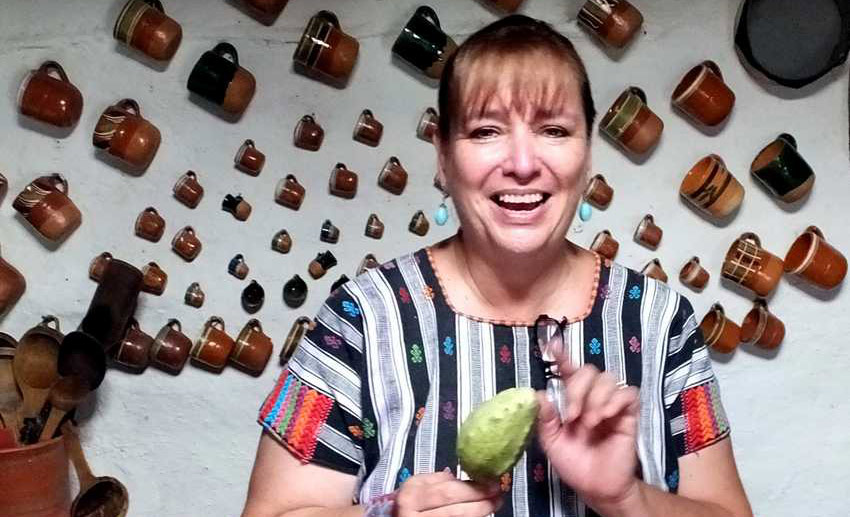Maru Toledo is an award-winning cook, culinary researcher, radio personality and author of at least 20 cookbooks, typically filled with fascinating anecdotes, interviews and, of course, recipes.
I first met Maru — years ago — beneath a thatched roof in the woods, near Jalisco’s famous circular pyramids, the Guachimontones.
She had invited us to a dinner that would be prepared using pre-Hispanic cooking techniques, which she had learned about both from oral tradition and from the findings of archaeologists with whom she has worked for years. It turned out to be the most unusual meal I have ever eaten.
The first dish on the menu was stone soup. The ingredients were shrimp, both dried and fresh, onions, chiles, epazote (wormseed), cherry tomatoes and jaltomates, western Mexico’s tiny but strongly flavored wild tomato. These ingredients were mixed into cold water inside a bule, a large bowl made from a gourd.
Maru’s helper, Godofredo, then removed a red-hot basalt rock from the fire and dropped it into the bowl. Instantly, the water was steaming and hissing and the soup was cooking.
Naturally, tortillas would go with the soup, but not the sort of tortillas popular today. Maru’s colleague, archaeologist Rodrigo Esparza, had discovered numerous traces of the tortillas eaten in western Mexico by pre-Hispanic people. “They turned out to be made of a mixture of corn and amaranth and were beautifully decorated with grana cochinilla.”
Cochineal is the celebrated red dye which — after gold — was the most sought-after commodity that the conquistadores got their hands on in the new world. This crimson dye is non-toxic and is made from the crushed bodies of tiny insects (Dactylopius coccus) which spend their lives sucking the juices of the prickly-pear cactus (nopal).
Cochineal, it seems, is making a big comeback because it is edible, whereas many synthetic red dyes are now thought to be carcinogenic.
Mesquite mushrooms were the main dish of our pre-Hispanic meal. The ingredients were few: mushrooms, a small amount of chile cora, a little salt and some mesquite pods. The cooking procedure, however, was most interesting, and again based on the discovery by archaeologists of how ancient peoples in Mexico cooked wild turkeys.
The mushroom mix was placed upon a banana leaf nearly a meter long and wrapped up to form a package about the size of a small loaf of bread, which was then tied up with tough agave fibers. Next came a curious step. Godofredo placed the “package” next to a large blob of nearly black mud. This, he told us, was clay from a nearby town famous for its pottery.

Carefully, he coated every side of the green bundle with a layer of clay about three centimeters thick until it looked exactly like a loaf of German black bread. He then rubbed ashes all over the outside of it and buried it in the campfire, under hot coals.
In about half an hour the baked mushrooms were ready. When Maru cracked open the now hard casing, the most savory aroma imaginable filled the air.
Our meal also included tamales prepared “the Mayan way” inside a large pot whose lid was sealed with dough. The tamales were tastily flavored with quelite, or amaranth greens, which were cultivated as a food crop here in Mexico some 7,000 years ago.
Once again those ancient Mexicans seem far ahead of us moderns in nutritional knowledge. We discovered that amaranth greens are a very good source of vitamin A, B6, C, riboflavin, iron, calcium, magnesium, phosphorus, potassium, copper, zinc and manganese. Popeye would have loved these tamales!
With all of this we drank a mixture of aguamiel (sweet juice from the heart of a living maguey root) and pineapple juice. Yes, pineapples, too, originated on this side of the Atlantic and were probably introduced to Europe by Christopher Columbus. The meal ended with a sweet, peanut-based dessert called coscoatl.
This was quite a delightful experience. Personally, I found the fire-baked mushrooms truly delicious, the shrimp soup wonderful and as for those original tortillas: well, they were okay, but I can see why Mexico switched to the nixtamalized maize tortillas popular today.
Maru Toledo lives in a little ranchito called Teuchiteco, 80 kilometers due west of Guadalajara at the foot of the Cerro de Las Piedras Bola, famed for its extraordinary giant stone balls.
“Welcome to the Smoky School of Gastronomy!” said Maru when I visited, explaining that at her place cooking is done the old way, without benefit of gas or electricity. We entered the kitchen, where Maru´s long-time associate Francisca “Pachita” Flores was making tacos de sol, sunshine tacos.
She was placing extra-large tortillas on a comal over a roaring fire. The masa, or dough, was brick brown in color and had been impregnated with a red chile sauce (and then kneaded on a metate, or grinding stone), Pachita explained.
Once a thick tortilla was ready, Pachita would remove it from the comal and immediately scrape off its entire top layer; this she handed to Maru who then put a large spoonful of picadillo (ground beef and potato plus spices) on top of it, folded it over and hermetically sealed the taco with mere finger pressure. Next, the tacos go out into the hot sun where they “bake” for an hour.
Finally, the sunshine tacos go into your mouth and I tell you these were the tastiest tacos I have ever eaten. The exterior was crispy but nevertheless melted in my mouth. It was so delicious it would have been a great treat all by itself, but in this case it was stuffed with amazingly flavorful picadillo. At that moment I felt that the humble taco had been transformed into a gourmet delicacy worthy of Le Cordon Bleu.
And apparently I was not alone in this assessment. Even celebrated chef Ricardo Muñoz Zurita, who was called by Time magazine “the prophet and preserver of (Mexico’s) culinary tradition,” has visited Maru’s Escuela de Humo.

